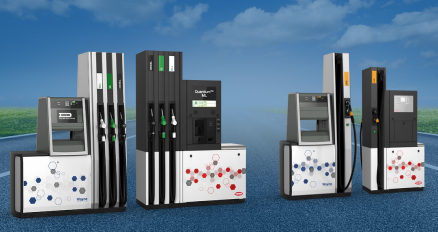
Despite the move towards decarbonization, internal combustion engine (ICE) vehicles are still prevalent in most markets and, according to some reports, will be in use long after 2030.
However, motorists continue to embrace greener transport, with many drivers considering which clean fuel is best for them, while fuel retailers are wondering which investment is best for business. With so much change, why is replacing conventional fuel dispensers so important?
The answer? Aging dispenser equipment will eventually need to be replaced to avoid breakdowns, as normal equipment wear and tear could lead to nozzles becoming inoperational, resulting in forecourt congestion and queuing.
New dispenser equipment would also ensure retailers are able to provide motorists with the best technology and user experience to cater and adapt to increasing consumer expectations.
In terms of longevity and low total cost of ownership (TCO), offering a mix of both clean and conventional fuels on one forecourt is a sure-fire way to satisfy consumer trends while staying one step ahead of the competition.
For modern businesses, change is not only healthy but essential for success; however, managing change comes at a cost. So, what is the cost of change should you decide to replace your conventional fuel dispensers
What is the Cost of Change?
Simply put, the cost of change is how much money you will need to pay to change or upgrade your service station. When it comes to fuel retailers, they will have to take into consideration the costs associated to install new equipment, remove old equipment, as well as any impact to revenue (e.g., due to out of use dispensers, etc.).
No matter the industry, the cost of change is something many will have had to take into consideration at one point or another, however, the change and uncertainty associated with the energy transition, as well as consumer trends, make the cost of change more prevalent.
It’s important to compare the potential costs of change versus not implementing anything at all. While it can seem easier to maintain the status quo rather than cause upheaval, the reality of doing nothing or delaying action could end up costing you more money in the long run.
Another way to look at it is this – can you afford to not keep your service station relevant, welcoming, and operational at a time when your competitors are making investments to ensure longevity?

Why it's Important to Look at Alternatives?
In recent years, the energy sector has seen a dramatic increase and focus on sustainable and clean energy sources, such as electric and hydrogen vehicles.
Although there are more electric vehicles (EVs) on European roads today than a decade ago, the population of electric cars is only predicted to be around 17% by 2030 (according to the 2022 European EV Charging Infrastructure Masterplan). In addition, hydrogen has only recently been introduced as a strong choice for long-haul, heavy-duty vehicles and other commercial transport in the last few years.
This means that over the next 10 years, there will still be many motorists who haven’t yet made the switch to cleaner fuels. In turn, this will result in the need for many petrol and diesel nozzles to remain in operation to refuel the remainder of the car population. Can fuel retailers be expected to effectively serve customers well into 2030 without replacing fuel pumps?
While developments in clean fuel infrastructure continue at pace, there is still a place for traditional fuels on the forecourt, particularly as the average lifespan of an EU ICE car is 12 years. Even though ICE car sales are decreasing, it’s pertinent to note that 2022 sales remained strong, with 52.8% of passenger car sales registered as petrol or diesel across the continent.
Fuel retailers will be required to carefully balance the needs of their customers during this period of transition and will have to invest in the replacement of aging conventional fuel dispensers at least once during this period, alongside their clean fuel investments.
Replacement of conventional fuel dispensers are needed to bridge the “gap” as motorists transition to cleaner fueled vehicles; thus, driving the need for the fuel retail and convenience industry to tailor their offering to match the evolving car population and mobility needs.
Challenges and Calculating the Cost of Change
When it comes to replacing fuel dispensers, it’s not always a straightforward process. There are many things that should be taken into consideration, such as how best to secure a new dispenser to the ground. For example, what installation frames already exist and how easy will it be to anchor a new dispenser? And how does the new dispenser connect to existing systems, such as the point-of-sale?
